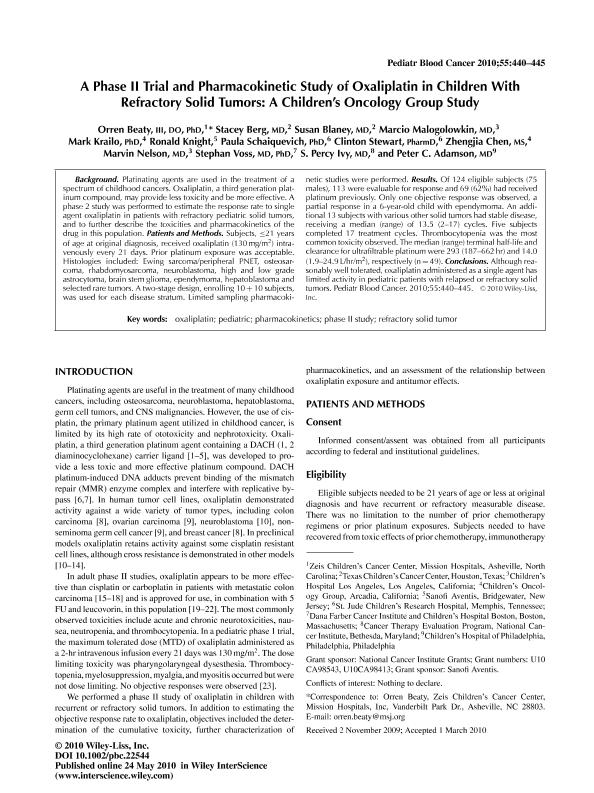Artículo
A phase II trial and pharmacokinetic study of oxaliplatin in children with refractory solid tumors: A Children's Oncology Group study
Beaty III, Orren; Berg, Stacey; Blaney, Susan; Malogolowkin, Marcio; Krailo, Mark; Knight, Ronald; Schaiquevich, Paula Susana ; Stewart, Clinton; Chen, Zhengjia; Nelson, Marvin; Voss, Stephan; Ivy, S. Percy; Adamson, Peter C.
; Stewart, Clinton; Chen, Zhengjia; Nelson, Marvin; Voss, Stephan; Ivy, S. Percy; Adamson, Peter C.
 ; Stewart, Clinton; Chen, Zhengjia; Nelson, Marvin; Voss, Stephan; Ivy, S. Percy; Adamson, Peter C.
; Stewart, Clinton; Chen, Zhengjia; Nelson, Marvin; Voss, Stephan; Ivy, S. Percy; Adamson, Peter C.
Fecha de publicación:
09/2010
Editorial:
Wiley-liss, div John Wiley & Sons Inc.
Revista:
Pediatric Blood & Cancer
ISSN:
1545-5009
Idioma:
Inglés
Tipo de recurso:
Artículo publicado
Clasificación temática:
Resumen
Background. Platinating agents are used in the treatment of a spectrum of childhood cancers. Oxaliplatin, a third generation platinum compound, may provide less toxicity and be more effective. A phase 2 study was performed to estimate the response rate to single agent oxaliplatin in patients with refractory pediatric solid tumors, and to further describe the toxicities and pharmacokinetics of the drug in this population. Patients and Methods. Subjects, ≤21 years of age at original diagnosis, received oxaliplatin (130 mg/m 2) intravenously every 21 days. Prior platinum exposure was acceptable. Histologies included: Ewing sarcoma/peripheral PNET, osteosarcoma, rhabdomyosarcoma, neuroblastoma, high and low grade astrocytoma, brain stem glioma, ependymoma, hepatoblastoma and selected rare tumors. A two-stage design, enrolling 10+10 subjects, was used for each disease stratum. Limited sampling pharmacokinetic studies were performed. Results. Of 124 eligible subjects (75 males), 113 were evaluable for response and 69 (62%) had received platinum previously. Only one objective response was observed, a partial response in a 6-year-old child with ependymoma. An additional 13 subjects with various other solid tumors had stable disease, receiving a median (range) of 13.5 (2-17) cycles. Five subjects completed 17 treatment cycles. Thrombocytopenia was the most common toxicity observed. The median (range) terminal half-life and clearance for ultrafiltrable platinum were 293 (187-662 hr) and 14.0 (1.9-24.9 L/hr/m2), respectively (n=49). Conclusions. Although reasonably well tolerated, oxaliplatin administered as a single agent has limited activity in pediatric patients with relapsed or refractory solid tumors.
Palabras clave:
OXALIPLATIN
,
PEDIATRIC
,
PHARMACOKINETICS
,
PHASE II STUDY
,
REFRACTORY SOLID TUMOR
Archivos asociados
Licencia
Identificadores
Colecciones
Articulos(SEDE CENTRAL)
Articulos de SEDE CENTRAL
Articulos de SEDE CENTRAL
Citación
Beaty III, Orren; Berg, Stacey; Blaney, Susan; Malogolowkin, Marcio; Krailo, Mark; et al.; A phase II trial and pharmacokinetic study of oxaliplatin in children with refractory solid tumors: A Children's Oncology Group study; Wiley-liss, div John Wiley & Sons Inc.; Pediatric Blood & Cancer; 55; 3; 9-2010; 440-445
Compartir
Altmétricas



